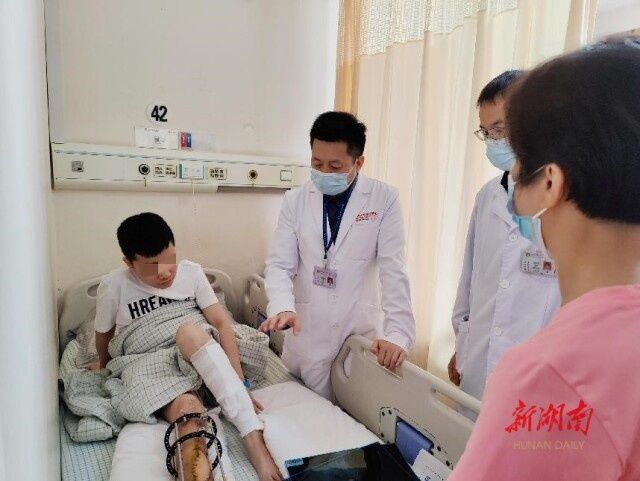Hunan Daily, May 15 (all media reporter Zhou Yangle correspondent Yu Hua Yan Xiaobo) The reporter learned today from Xiangya Hospital of Central South University that Xiao Xu, a 17-year-old patient with congenital tibial pseudarthrosis, sent a message to Professor Tang Juyu, director of the Department of Orthopedics, for his recent recovery. ‘s video. Previously, Tang Juyu’s team created the best surgical technique through the technique of “blood flow bridging chimeric peroneal artery perforator flap grafting and grafting Ilizarov (Ilizarov)”, and only three-stage surgery was used to help him resume walking without crutches. It is reported that this is the first innovative integrated application of Ilizarov technology and peroneal artery chimeric perforator flap technology in the world.

Xiao Xu from Hengyang developed a bent right calf when he was 3 years old. Accompanied by his family, he went to Guangzhou, Shanghai, He consulted many hospitals in Beijing, Hengyang and other places and was diagnosed with “right congenital tibial pseudoarthrosis and neurofibromatosis”. Congenital pseudarthrosis of the tibia is relatively rare, with an incidence of approximately 1 in 300,000, and is characterized by segmental dysplasia of the tibia with angular deformity, pathological fractures, and nonunion. Because the exact etiology and pathogenesis are still unclear, and the treatment is difficult, it is called “the world’s problem”.
Since 2013, Xiao Xu has undergone more than 10 surgeries, with a single hospital stay of up to 46 days. Despite this, his disease has not been cured, and he has suffered from angular deformity of the tibia, shortened limbs, non-union of fractured ends, and pus from wound infection. For the past three years, he has to live on crutches and suffer from pain. After many inquiries, the family took Xiao Xu to find Tang Juyu.
Tang Juyu communicated patiently with Xiaoxu’s mother: “Xiaoxu’s condition is very complicated. To solve Xiaoxu’s various problems, first of all, thorough debridement and infection control; secondly, lengthening limbs and correcting deformities; thirdly The third is microscopic reconstruction, reconstructing the function of the affected limb; the fourth is rehabilitation exercise.”
After repeated research and discussion, Tang Juyu’s team formulated a detailed personalized treatment plan, and decided to put the Xiangya Microsurgery team in the early stage. The developed blood flow bridging chimeric peroneal artery perforator flap grafting technology is integrated with the Ilizarov technology, which is also the best operation for this patient at present.
On March 1, Tang Juyu performed debridement and bone lengthening of the broken end of the tibia of the right lower extremity for Xiao Xu, completely removed the necrotic tissue, and then fixed it with an external fixator. Post-guided extended adjustments. After more than a month, Xiao Xu’s lower limbs were basically the same length, which gave him and his family the hope of a complete cure. However, the third stage surgery is the real challenge. “The key to the operation is to reconstruct the 14cm defect of the tibia through blood flow bridging-the grafting of the fibular artery perforator flap.” Considering the insufficient supporting strength of the single-segment fibular flap, the team cleverly designed a double-segment fibular flap graft. At the same time, the peroneal artery perforator skin flap is carried, which not only ensures sufficient support strength for the bone defect reconstructed by transplantation, but also provides a good coverage of the wound through the skin flap, which is conducive to better wound healing and avoids sacrificing the tibia. Anterior main artery, preventing the occurrence of ankle valgus deformity.
On April 13, according to the preoperative design ideas, the team cut a 30cm long fibula from the patient’s left calf, and carried the perforator flap of the peroneal artery together, divided the bone flap into two, and reassembled the fibula. After splicing, it was transplanted to the bone defect of the right tibia, the tibial continuity was reconstructed with a double-segment bone flap, the peroneal artery perforator flap was used to repair the wound, and the blood circulation of the double-segment fibular flap and the peroneal artery perforator flap was reconstructed using the blood flow bridging technique. , while reconstructing the continuity of the anterior tibial artery.
The entire operation was successfully completed. The patient’s tibia is perfectly reconstructed, the donor site is non-invasively dissected, the wound is directly closed, and the trauma is minimized. The left lateral ankle was treated to prevent the occurrence of valgus deformity of the ankle joint, and the fixation of the right ankle joint was successfully released, which is expected to restore the function of the right ankle joint to the maximum extent, which is another advantage over other treatment methods.
“I have never cried before. I am very grateful to Professor Tang, and to the doctors and nurses of Xiangya Hospital!” Xiao Xu’s mother said happily.
[Editor in charge: Li Chuanxin]
[Source: Hunan Daily]